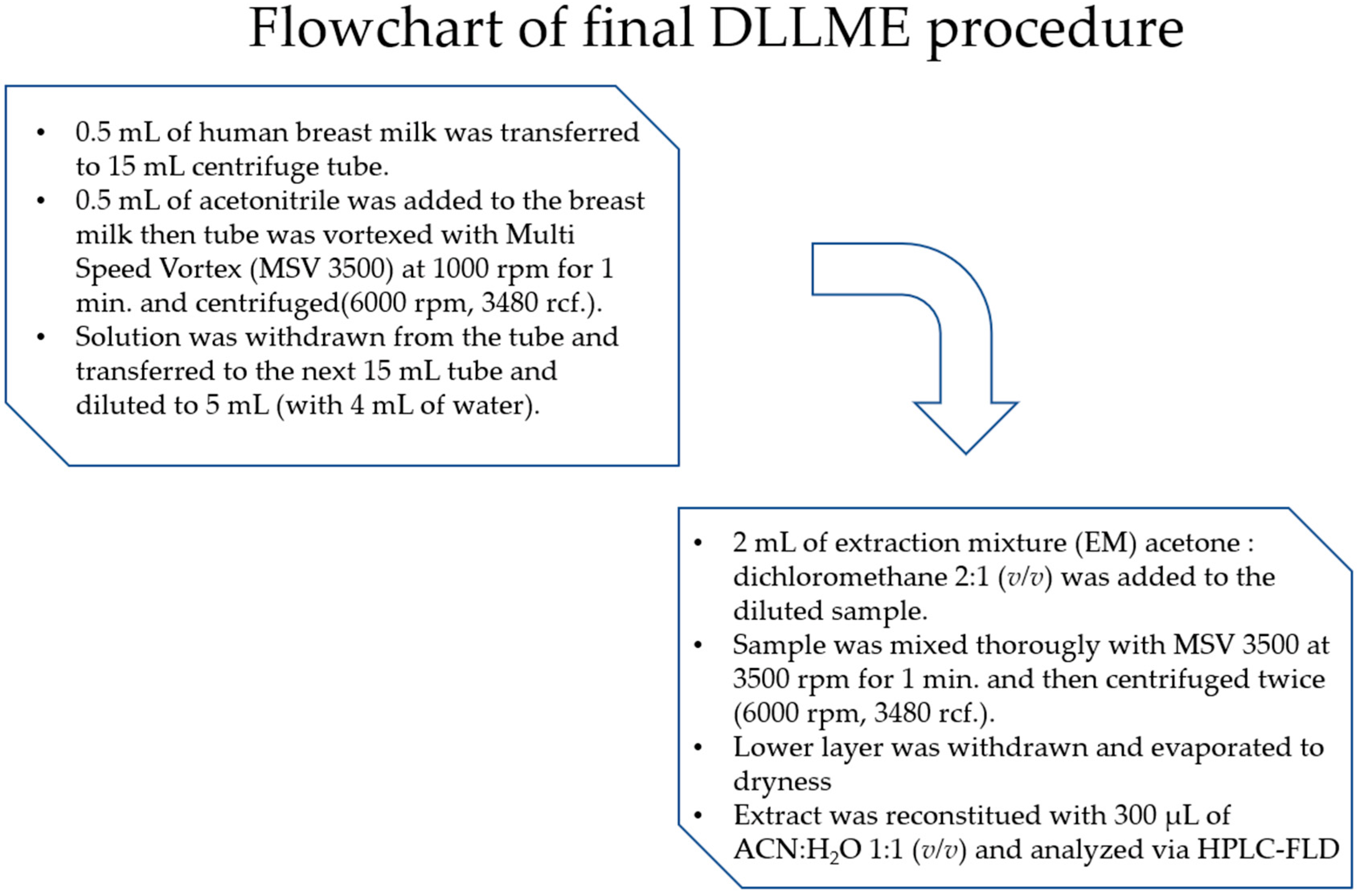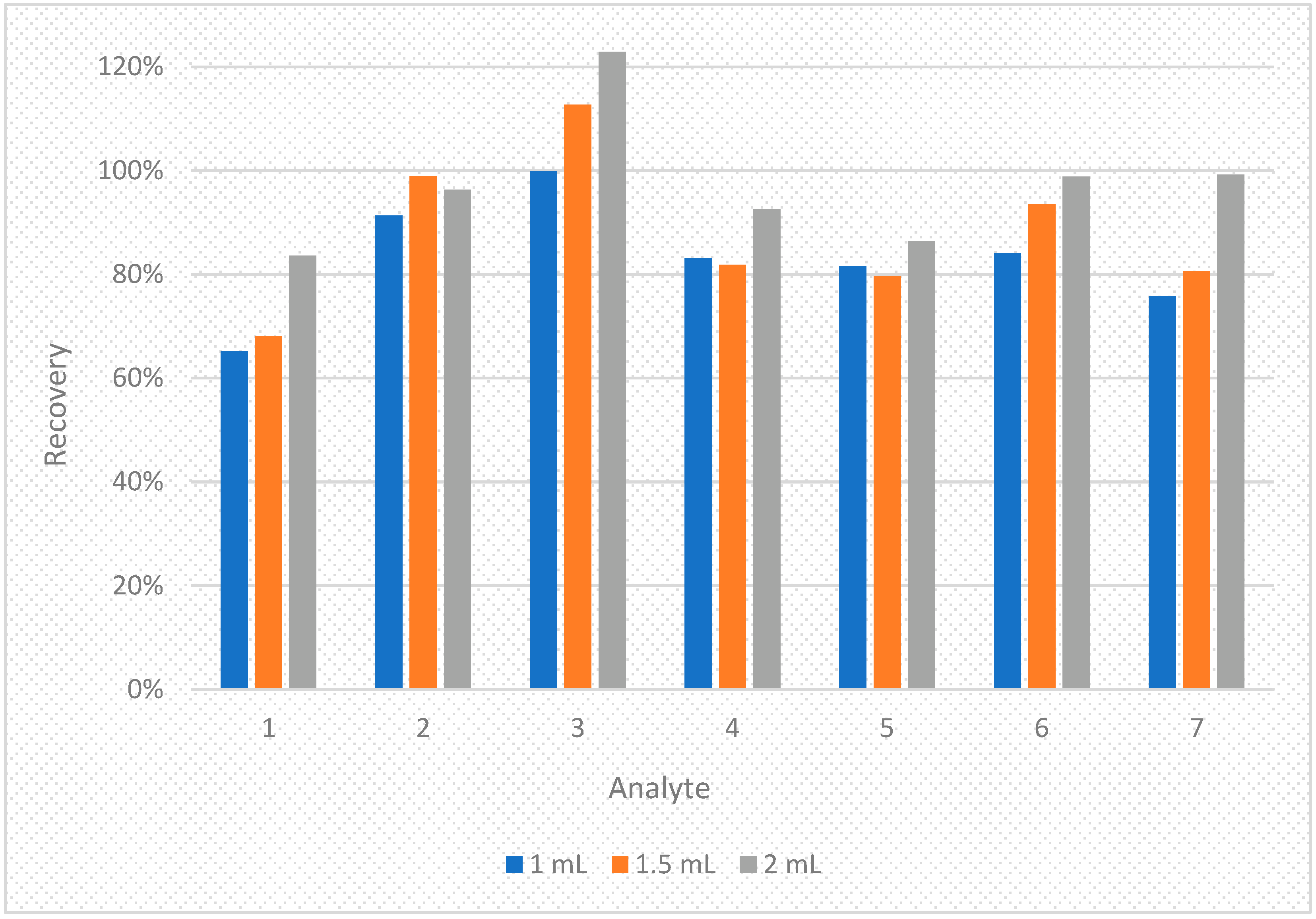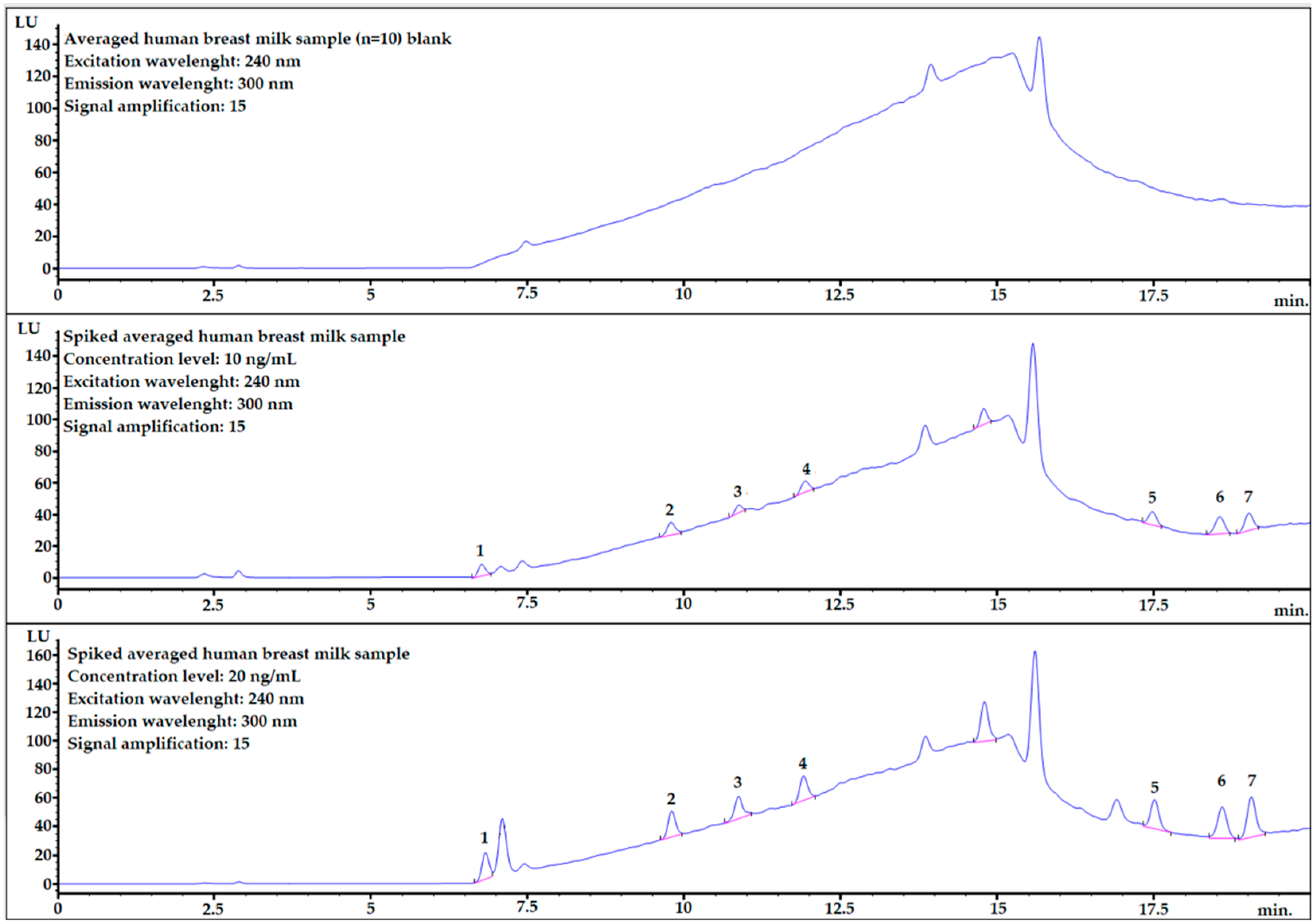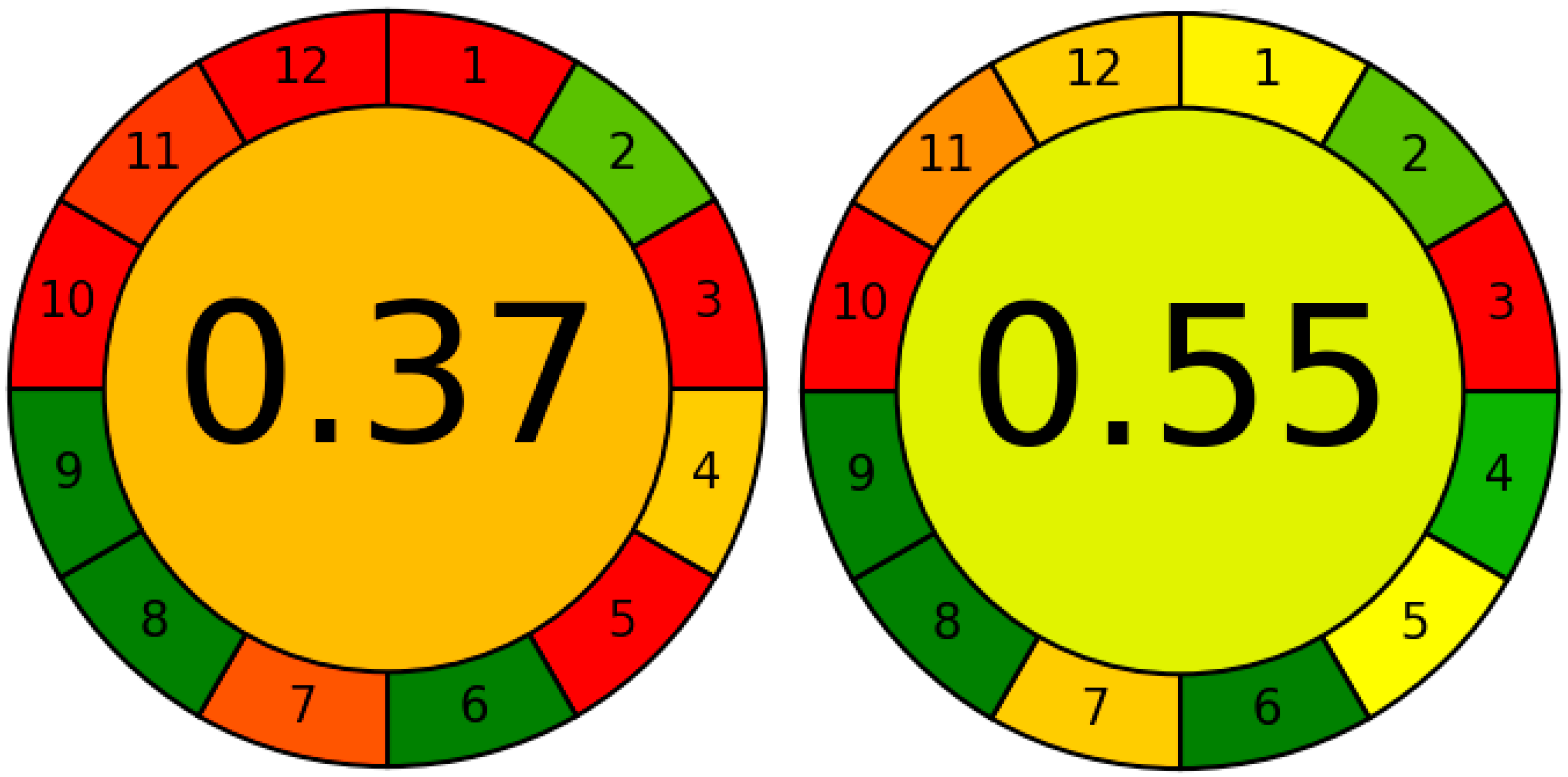A Fast Method for Determination of Seven Bisphenols in Human Breast Milk Samples with the Use of HPLC-FLD
Abstract
:1. Introduction
2. Results
2.1. Optimizing the Chromatographic Parameters
2.2. Optimizing the Detection Conditions
2.3. Optimizing the DLLME Procedure for Human Breast Milk Samples
2.4. Recovery Studies
2.5. Quantitative Analysis
3. Discussion
- The sample preparation technique was significantly accelerated. Previously, the dispersive solid-phase extraction (d-SPE) before SPE (Oasis HLB column) was performed as a sample preparation technique. In this study, samples were prepared using the DLLME-based technique.
- The sample volume stayed at the same level (0.5 mL).
- The number of analyzed BPs stayed the same; however, in this study the most common bisphenol—BPA—was added to the study.
- The LOD and LOQ values were much lower than in previous wors. In this work, the LOD was 0.5–2.1 ng/mL, whereas in previous work, the LOD was 56.7–77.6 ng/mL.
4. Materials and Methods
4.1. Chemical Reagents and Bisphenols Standards
4.2. Instrumental Analysis
4.3. Method Validation
4.4. Selectivity
4.5. Linearity
4.6. Optimizing the DLLME Procedure
4.7. Recovery Studies
- A—Peak area of the analyte obtained after procedure where sample were spiked before DLLME extraction.
- B—Peak area of analyte obtained after procedure where sample were spiked after DLLME extraction directly into vial.
- C—Standard deviation of the recovery (%).
- D—Mean recovery (%).
4.8. Sample Collection and Storage
4.9. Evaluation of ‘Greenness’ of the Presented Method
5. Conclusions
Author Contributions
Funding
Institutional Review Board Statement
Informed Consent Statement
Data Availability Statement
Acknowledgments
Conflicts of Interest
Sample Availability
References
- Jiang, B.; Kauffman, A.; Li, L.; McFee, W.; Cai, B.; Weinstein, J.; Lead, J.; Chatterjee, S.; Scott, G.; Xiao, S. Health impacts of environmental contamination of micro- and nanoplastics: A review. Environ. Health Prev. Med. 2020, 25, 29. [Google Scholar] [CrossRef] [PubMed]
- Ocaña-Rios, I.; de Jesús Olmos-Espejel, J.; Donkor, K.K. Recent advances in analysis of bisphenols and their derivatives in biological matrices. Anal. Bioanal. Chem. 2021, 414, 807–846. [Google Scholar] [CrossRef] [PubMed]
- Tuzimski, T.; Szubartowski, S. Application of Solid-Phase Extraction and High-Performance Liquid Chromatography with Fluorescence Detection to Analyze Eleven Bisphenols in Amniotic Fluid Samples Collected during Amniocentesis. Int. J. Environ. Res. Public Health 2022, 19, 2309. [Google Scholar] [CrossRef] [PubMed]
- Tuzimski, T.; Szubartowski, S. Method development for selected bisphenols analysis in sweetened condensed milk from a can and breast milk samples by HPLC–DAD and HPLC-QqQ-MS: Comparison of sorbents (Z-Sep, Z-Sep plus, PSA, C18, chitin and EMR-Lipid) for clean-up of QuEChERS extract. Molecules 2019, 24, 2093. [Google Scholar] [CrossRef]
- Michałowicz, J. Bisphenol A—Sources, toxicity and biotransformation. Environ. Toxicol. Pharmacol. 2014, 37, 738–758. [Google Scholar] [CrossRef]
- European Commission. Commission Regulation (EU) 2018/213 of 12 February 2018 on the use of bisphenol A in varnishes and coatings intended to come into contact with food and amending Regulation (EU) No 10/2011 as regards the use of that substance in plastic food contact materi. Off. J. Eur. Union 2018, 2001, 20–30. [Google Scholar]
- European Commission. European Commision Regulation No 321/2011 Amending Regulation (EU) No 10/2011 as Regards the Restriction of Use of Bisphenol A in Plastic Infant Feeding Bottles; European Union: Brussels, Belgium, 2011. [Google Scholar]
- Chen, D.; Kannan, K.; Tan, H.; Zheng, Z.; Feng, Y.L.; Wu, Y.; Widelka, M. Bisphenol Analogues Other Than BPA: Environmental Occurrence, Human Exposure, and Toxicity—A Review. Environ. Sci. Technol. 2016, 50, 5438–5453. [Google Scholar] [CrossRef]
- Ji, Z.; Liu, J.; Sakkiah, S.; Guo, W.; Hong, H. BPA Replacement Compounds: Current Status and Perspectives. ACS Sustain. Chem. Eng. 2021, 9, 2433–2446. [Google Scholar] [CrossRef]
- Adegoke, E.O.; Rahman, M.S.; Pang, M.G. Bisphenols Threaten Male Reproductive Health via Testicular Cells. Front. Endocrinol. 2020, 11, 624. [Google Scholar] [CrossRef]
- Kim, M.J.; Park, Y.J. Bisphenols and thyroid hormone. Endocrinol. Metab. 2019, 34, 340–348. [Google Scholar] [CrossRef]
- European Union. Commission Regulation (EU) No 10/2011 of 14 January 2011; European Union: Brussels, Belgium, 2011. [Google Scholar]
- European Commisssion. European Commisssion Regulation (EC) No 1895/2005 of 18 November 2005 on the Restriction of Use of Certain Epoxy Derivatives in Materials and Articles Intended to Come into Contact with Food; European Union: Brussels, Belgium, 2005. [Google Scholar]
- Basak, S.; Das, M.K.; Duttaroy, A.K. Plastics derived endocrine-disrupting compounds and their effects on early development. Birth Defects Res. 2020, 112, 1308–1325. [Google Scholar] [CrossRef]
- Andreas, N.J.; Kampmann, B.; Mehring Le-Doare, K. Human breast milk: A review on its composition and bioactivity. Early Hum. Dev. 2015, 91, 629–635. [Google Scholar] [CrossRef]
- Iribarne-Durán, L.M.; Peinado, F.M.; Freire, C.; Castillero-Rosales, I.; Artacho-Cordón, F.; Olea, N. Concentrations of bisphenols, parabens, and benzophenones in human breast milk: A systematic review and meta-analysis. Sci. Total Environ. 2022, 806, 150437. [Google Scholar] [CrossRef]
- Czarczyńska-Goślińska, B.; Grześkowiak, T.; Frankowski, R.; Lulek, J.; Pieczak, J.; Zgoła-Grześkowiak, A. Determination of bisphenols and parabens in breast milk and dietary risk assessment for Polish breastfed infants. J. Food Compos. Anal. 2021, 98, 103839. [Google Scholar] [CrossRef]
- Tuzimski, T.; Pieniążek, D.; Buszewicz, G.G.; Teresiński, G.G. QuEChERS-based extraction procedures for the analysis of bisphenols S and A in breast milk samples by LC-QqQ-MS. J. AOAC Int. 2019, 102, 23–32. [Google Scholar] [CrossRef]
- Tuzimski, T.; Szubartowski, S.; Gadzała-Kopciuch, R.; Miturski, A.; Wójtowicz-Marzec, M.; Kwaśniewski, W.; Buszewski, B. Comparison of DAD and FLD Detection for Identification of Selected Bisphenols in Human Breast Milk Samples and Their Quantitative Analysis by LC-MS/MS. J. AOAC Int. 2020, 103, 1029–1042. [Google Scholar] [CrossRef]
- Dualde, P.; Pardo, O.; Fernández, S.F.; Yusà, V. Determination of four parabens and bisphenols A, F and S in human breast milk using QuEChERS and liquid chromatography coupled to mass spectrometry. J. Chromatogr. B 2019, 1114–1115, 154–166. [Google Scholar] [CrossRef]
- Lee, J.; Choi, K.; Park, J.; Moon, H.-B.; Choi, G.; Lee, J.J.; Suh, E.; Kim, H.-J.; Eun, S.-H.; Kim, G.-H.; et al. Bisphenol A distribution in serum, urine, placenta, breast milk, and umbilical cord serum in a birth panel of mother–neonate pairs. Sci. Total Environ. 2018, 626, 1494–1501. [Google Scholar] [CrossRef]
- Filippou, O.; Deliyanni, E.A.; Samanidou, V.F. Fabrication and evaluation of magnetic activated carbon as adsorbent for ultrasonic assisted magnetic solid phase dispersive extraction of bisphenol A from milk prior to high performance liquid chromatographic analysis with ultraviolet detection. J. Chromatogr. A 2017, 1479, 20–31. [Google Scholar] [CrossRef]
- Tuzimski, T.; Szubartowski, S. Application of d-SPE before SPE and HPLC-FLD to Analyze Bisphenols in Human Breast Milk Samples. Molecules 2021, 26, 4930. [Google Scholar] [CrossRef]
- Rezaee, M.; Assadi, Y.; Milani Hosseini, M.R.; Aghaee, E.; Ahmadi, F.; Berijani, S. Determination of organic compounds in water using dispersive liquid-liquid microextraction. J. Chromatogr. A 2006, 1116, 1–9. [Google Scholar] [CrossRef] [PubMed]
- Vela-Soria, F.; Jiménez-Díaz, I.; Díaz, C.; Pérez, J.; Iribarne-Durán, L.M.; Serrano-López, L.; Arrebola, J.P.; Fernández, M.F.; Olea, N. Determination of endocrine-disrupting chemicals in human milk by dispersive liquid-liquid microextraction. Bioanalysis 2016, 8, 1777–1791. [Google Scholar] [CrossRef] [PubMed]
- Orzel, J.; Swit, P. Comparison of quantitative detection methods based on molecular fluorescence spectroscopy and chromatographic techniques used for the determination of bisphenol compounds. Int. J. Mol. Sci. 2021, 22, 10569. [Google Scholar] [CrossRef] [PubMed]
- Tuzimski, T.; Szubartowski, S. Application of Solid Phase Extraction and High-Performance Liquid Chromatography with Fluorescence Detection to Analyze Bisphenol A Bis (2,3-Dihydroxypropyl) Ether (BADGE 2H2O), Bisphenol F (BPF), and Bisphenol E (BPE) in Human Urine Samples. Int. J. Environ. Res. Public Health 2021, 18, 10307. [Google Scholar] [CrossRef]
- Rocha, B.A.; Da Costa, B.R.B.; De Albuquerque, N.C.P.; De Oliveira, A.R.M.; Souza, J.M.O.; Al-Tameemi, M.; Campiglia, A.D.; Barbosa, F. A fast method for bisphenol A and six analogues (S, F, Z, P, AF, AP) determination in urine samples based on dispersive liquid-liquid microextraction and liquid chromatography-tandem mass spectrometry. Talanta 2016, 154, 511–519. [Google Scholar] [CrossRef]
- Pastor-Belda, M.; Bastida, D.; Campillo, N.; Pérez-Cárceles, M.D.; Motas, M.; Viñas, P. A study of the influence on diabetes of free and conjugated bisphenol A concentrations in urine: Development of a simple microextraction procedure using gas chromatography–mass spectrometry. J. Pharm. Biomed. Anal. 2016, 129, 458–465. [Google Scholar] [CrossRef]
- de Oliveira, M.L.; Rocha, B.A.; de Oliveira Souza, V.C.; Barbosa, F. Determination of 17 potential endocrine-disrupting chemicals in human saliva by dispersive liquid-liquid microextraction and liquid chromatography-tandem mass spectrometry. Talanta 2019, 196, 271–276. [Google Scholar] [CrossRef]
- González, N.; Cunha, S.C.; Monteiro, C.; Fernandes, J.O.; Marquès, M.; Domingo, J.L.; Nadal, M. Quantification of eight bisphenol analogues in blood and urine samples of workers in a hazardous waste incinerator. Environ. Res. 2019, 176, 108576. [Google Scholar] [CrossRef]
- Szubartowski, S.; Tuzimski, T. Application of High-Performance Liquid Chromatography Combined with Fluorescence Detector and Dispersive Liquid–Liquid Microextraction to Quantification of Selected Bisphenols in Human Amniotic Fluid Samples. Int. J. Environ. Res. Public Health 2022, 20, 297. [Google Scholar] [CrossRef]
- Pena-Pereira, F.; Wojnowski, W.; Tobiszewski, M. AGREE—Analytical GREEnness Metric Approach and Software. Anal. Chem. 2020, 92, 10076–10082. [Google Scholar] [CrossRef]






| No. | Bisphenol | tR (min.) | Linear Regression | SD of Slope | Coefficient of Determination (R2) | LOD (ng/mL) | LOQ (ng/mL) |
|---|---|---|---|---|---|---|---|
| 1 | BADGE∙2H2O | ~6.84 | y = 14.87x + 0.60 | 0.30 | 0.9988 | 0.8 | 2.5 |
| 2 | BPF | ~9.84 | y = 6.74x + 10.23 | 0.31 | 0.9940 | 2.1 | 6.3 |
| 3 | BPE | ~10.93 | y = 9.91x + 4.47 | 0.16 | 0.9989 | 0.6 | 1.8 |
| 4 | BPA | ~11.98 | y = 4.45x + 10.97 | 0.19 | 0.9929 | 1.5 | 4.7 |
| 5 | BADGE∙2HCl | ~17.64 | y = 19.36x + 17.05 | 0.24 | 0.9994 | 0.5 | 1.4 |
| 6 | BADGE | ~18.73 | y = 11.65x + 26.89 | 0.23 | 0.9985 | 0.7 | 2.2 |
| 7 | BPP | ~19.19 | y = 11.735x + 12.38 | 0.62 | 0.9923 | 2.1 | 6.3 |
| No. | Bisphenol | Concentration Level | |||
|---|---|---|---|---|---|
| 10 (n = 18) | 20 (n = 18) | ||||
| Recovery (%) | RSD% | Recovery (%) | RSD% | ||
| 1 | BADGE∙2H2O | 67% | 11% | 72% | 11% |
| 2 | BPF | 101% | 11% | 108% | 16% |
| 3 | BPE | 97% | 10% | 108% | 17% |
| 4 | BPA | 102% | 16% | 110% | 8% |
| 5 | BADGE∙2HCl | 88% | 12% | 90% | 11% |
| 6 | BADGE | 99% | 11% | 85% | 7% |
| 7 | BPP | 76% | 7% | 82% | 11% |
| Patient | Concentration Level |
|---|---|
| 1 | ND |
| 2 | <LOQ |
| 3 | ~LOD |
| 4 | ND |
| 5 | ND |
| 6 | <LOQ |
| 7 | ND |
| 8 | ND |
| 9 | ~LOD |
| 10 | ~LOD |
Disclaimer/Publisher’s Note: The statements, opinions and data contained in all publications are solely those of the individual author(s) and contributor(s) and not of MDPI and/or the editor(s). MDPI and/or the editor(s) disclaim responsibility for any injury to people or property resulting from any ideas, methods, instructions or products referred to in the content. |
© 2023 by the authors. Licensee MDPI, Basel, Switzerland. This article is an open access article distributed under the terms and conditions of the Creative Commons Attribution (CC BY) license (https://creativecommons.org/licenses/by/4.0/).
Share and Cite
Szubartowski, S.; Tuzimski, T. A Fast Method for Determination of Seven Bisphenols in Human Breast Milk Samples with the Use of HPLC-FLD. Molecules 2023, 28, 1432. https://doi.org/10.3390/molecules28031432
Szubartowski S, Tuzimski T. A Fast Method for Determination of Seven Bisphenols in Human Breast Milk Samples with the Use of HPLC-FLD. Molecules. 2023; 28(3):1432. https://doi.org/10.3390/molecules28031432
Chicago/Turabian StyleSzubartowski, Szymon, and Tomasz Tuzimski. 2023. "A Fast Method for Determination of Seven Bisphenols in Human Breast Milk Samples with the Use of HPLC-FLD" Molecules 28, no. 3: 1432. https://doi.org/10.3390/molecules28031432
APA StyleSzubartowski, S., & Tuzimski, T. (2023). A Fast Method for Determination of Seven Bisphenols in Human Breast Milk Samples with the Use of HPLC-FLD. Molecules, 28(3), 1432. https://doi.org/10.3390/molecules28031432







